Category: Places
April 6, 2012
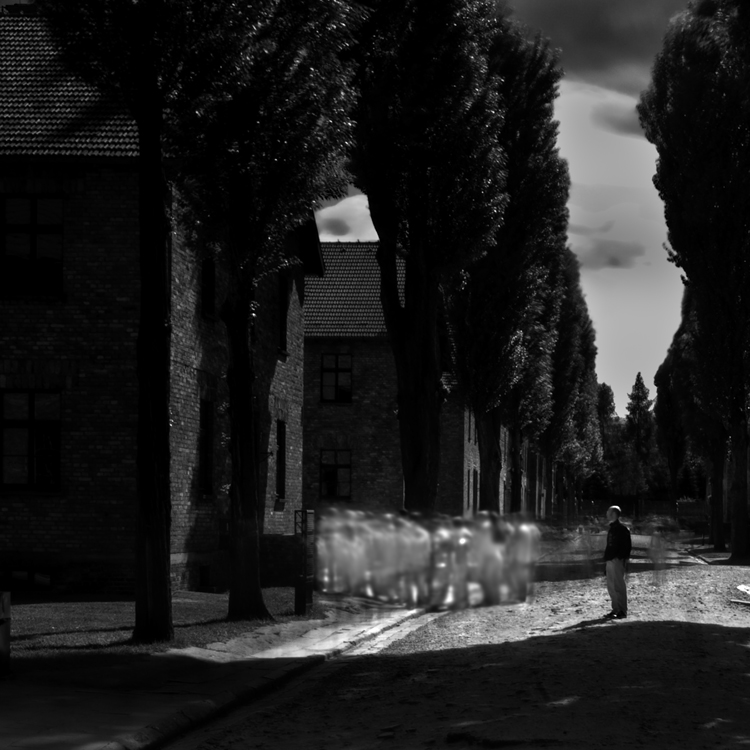
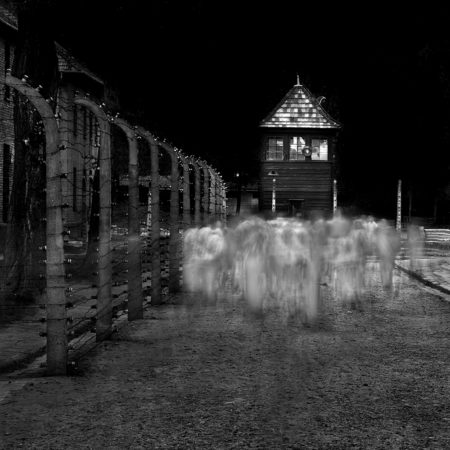
I would like to tell the story behind “The Ghosts of Auschwitz-Birkenau.”
My wife and I were visiting my son who was serving in the Peace Corps in Ukraine (providing balance to his two brothers who were serving in the Marines). Being part Polish, we decided to visit our homeland and took a train to Krakow. Upon arriving discussions began on what to see and of course Auschwitz-Birkenau was high on the list, but secretly I hoped we wouldn’t visit the camps because I did not want see a place of such sadness. However my wife wanted to go and so I agreed.
We took a bus tour that would spend about 1 hour at Auschwitz and 30 minutes at Birkenau. Even though I had my camera equipment with me, I had not planned on photographing the camps because it seemed that this might be disrespectful. The tour began indoors and we saw the meticulous records the German’s kept of their victims and then the piles of personal effects: glasses, shoes, hair and other items.
This was just too overwhelming and I felt like I was suffocating, so I signaled my family that I was going outdoors. Breathing in the open air I began to feel a bit better and slowly walked, looking down at my feet. The thought then came to me: how many had walked here before me, in these exact same footsteps and now were dead? How many had taken this same path and then had been murdered?
I began to wonder if the spirits of those who were dead still lingered, did they still inhabit this place? And then it suddenly struck me that I must photograph the spirits of those who had died here. I instinctively knew how I would do that, I would use long exposures of the other visitors at the camps, who would stand in proxy for the dead. The enormity of this task hit me as I realized that the bus was leaving in 45 minutes and so I ran from location to location, working incredibly fast.
Each location had its own challenges, I had to photograph people without their knowing it, because if they thought I was photographing they would politely move out of my way. I developed techniques to fool people into thinking I was not photographing, I would set up my equipment and then talk on the phone or look in my camera bag, and then trigger the camera with a remote shutter release.
I found that the closer I was to the scene, the harder it was to get the shot because people would see me and move out of my way, not knowing that I actually needed them in the picture! Auschwitz No. 9 was the most difficult image to get, it took many exposures to capture these ghosts.
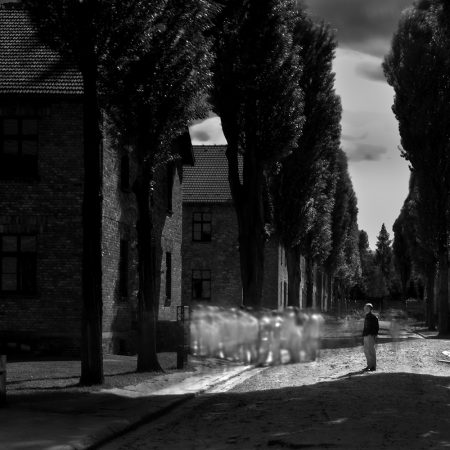
Another challenge was that people had to keep moving to produce the ghosting effects. So many shots were ruined when someone in the group would stop and interrupt the ghosting effect. In one image, Auschwitz No. 4, a man in the group stopped to read a historical placard. This is the only image that I’ve included a “mortal” because it seemed to say “I am completely unaware of the ghosts around me.”
It’s no simple matter to get the right ghosting effects; so many factors affect the image such as the color of the clothing people are wearing, the speed in which they walk, the angle they are walking in relation to the camera and of course the length of the exposure. I had to learn all of this in very short order and I was so grateful to be using digital so that I could get immediate feedback. There was so much to learn in such a short time, but I knew I had to finish before the bus left as I would not have another chance.
In one sense I felt prepared for this moment, for this opportunity. I had been working with long exposures for several years and I understood the basics, however I had never worked with people before and certainly not with unsuspecting subjects. I had to learn quickly and work quickly.
I do feel that I was inspired, both in concept and execution. As I looked at each scene I knew in my mind exactly how the finished image would look. However if you were to see the original shots and compare them to the final images, you would be surprised to see the extensive Photoshop work it took to bring the “shot” into compliance with my vision.
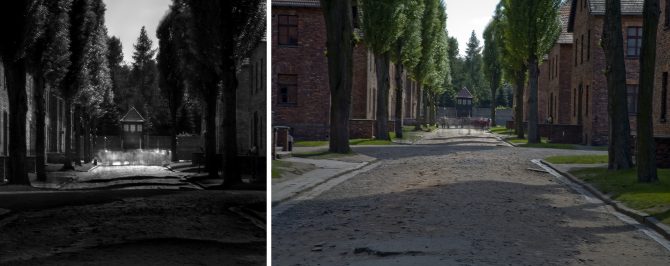
My processing included cropping the image to a square, darkening the scene for an almost nighttime look, increasing contrast, dodging up the ghosts and burning down distracting elements. You can see one “before and after” example above. Vision was the key to this series (remember my Rule of Thirds) and it was the constant that drove everything. You can view the entire Ghosts portfolio here.
Auschwitz-Birkenau is a depressing place, but I am glad that I went. I hope my images can portray the camps not just as a historical location, but as a place where real people lived and died.
Cole
P.S. I recently had the honor of meeting a group of Holocaust survivors who attended the opening of this exhibition in Dallas. I saw a very elderly woman in a wheel chair looking at my images and I introduced myself by saying: “Hi, my name is Cole Thompson and these are my images.” She responded by pointing at the wall and exclaiming: “These are my images!”
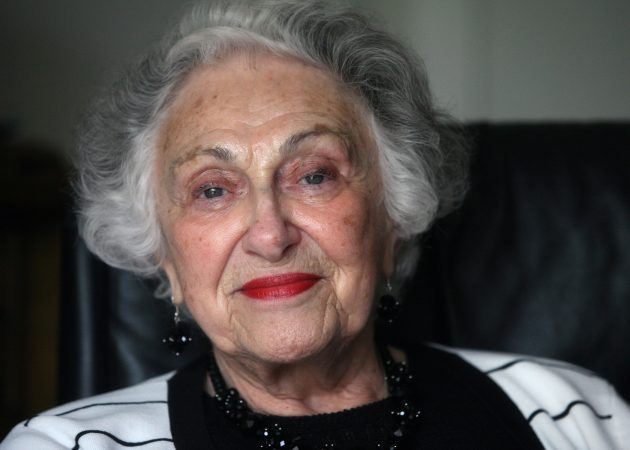
Her name was Edith Molnar and she had been interned at Auschwitz and recognized these locations. That was a humbling moment, to appreciate that you were talking to someone who had lived through these horrors, she was “living history.” Edith passed away several weeks later.
Cole
March 30, 2012
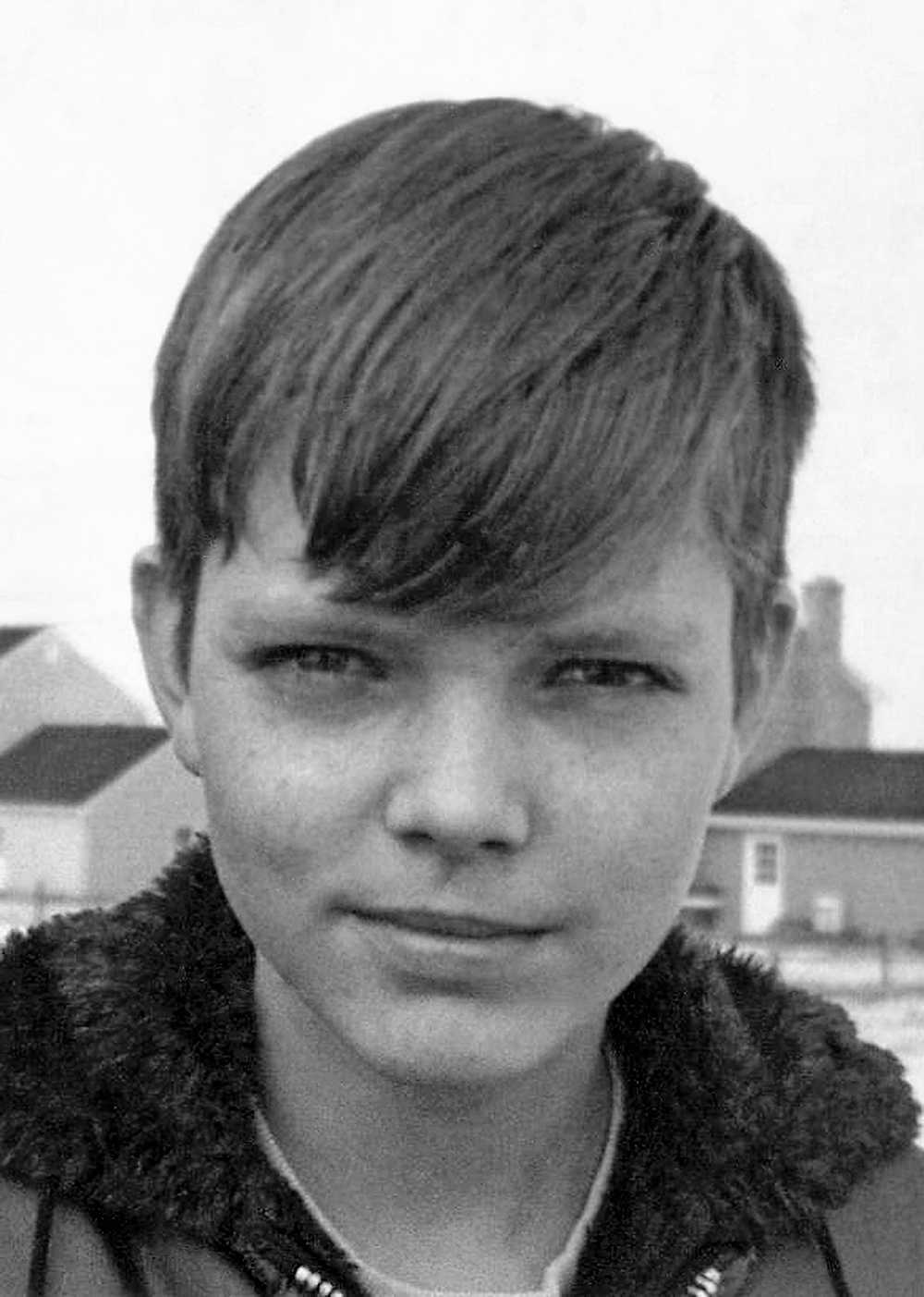

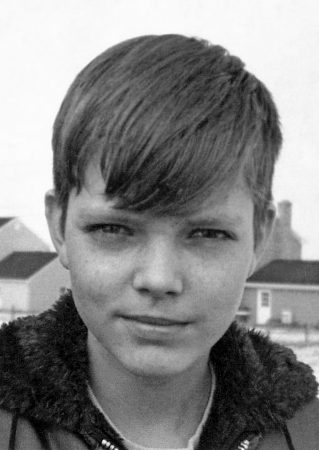
I was a 14 year old boy living in Rochester, NY when I discovered photography. Now some 45 years later I return to Rochester to exhibit, speak and conduct a workshop.
I will be exhibiting “The Ghosts of Auschwitz-Birkenau” and speaking about my experience at the Death Camps and well as sharing impressions from my meetings with Holocaust survivors.
My workshop is titled “Simple Secrets to Great Black and White Photography” and I’ll be sharing my “simple” philosophy, demonstrating my long exposure techniques and showing how I process my b&w images while using only six tools in Photoshop.
All events will be conducted at:
Image City Photography Gallery
722 University Ave.
Rochester, NY 14607
http://www.imagecityphotographygallery.com/
585-271-2540
March 15, 2012
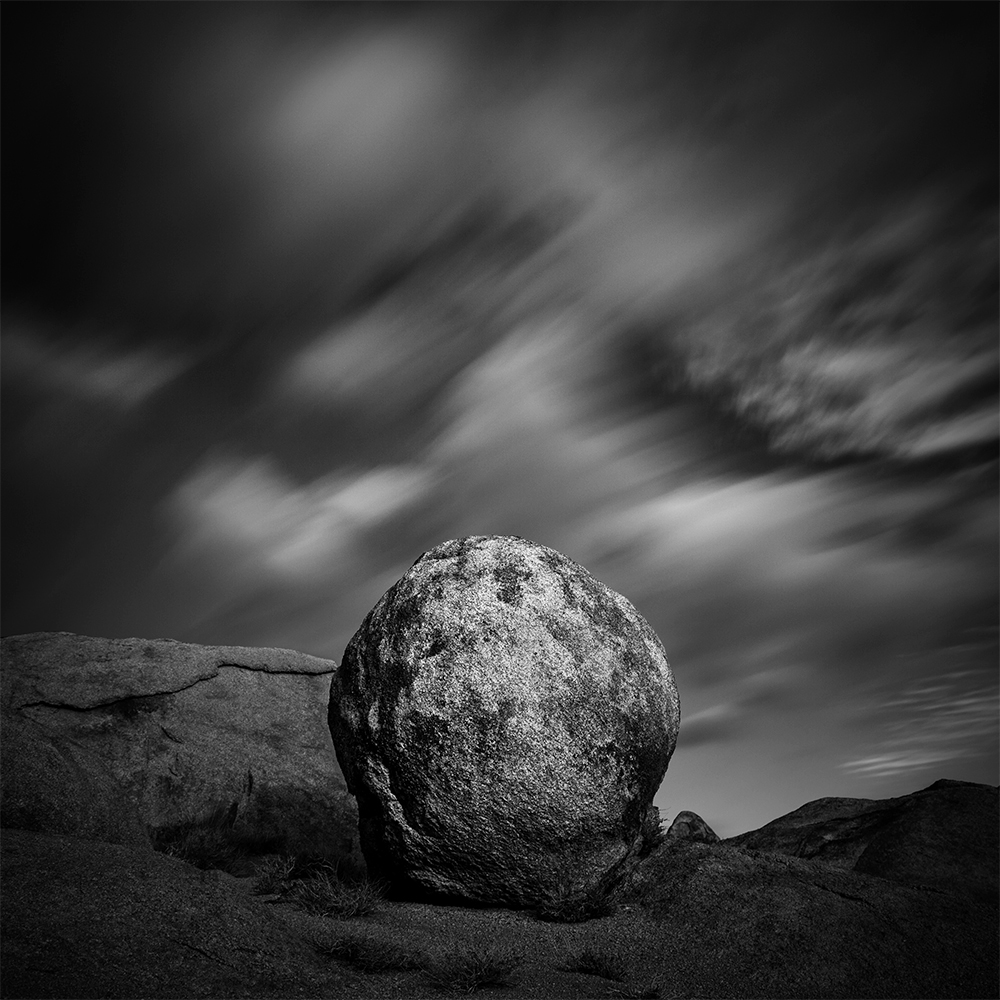


I recently spent time in Joshua Tree National Park in California, it was the first time I had visited there since 1987 when my wife I went camping. Coincidently our trip occurred right after U2 had introduced their new album “Joshua Tree” and I remember listening to it non-stop as we sunned ourselves on the large round boulders at the park. The music and that location were positively and indelibly embedded in my memory and each time I hear those songs I am transported back in time. So it was with great nostalgia and anticipation that I returned, hoping to find inspiration at this wonderful place.
As I headed to Joshua Tree I had no idea of how others had portrayed it, nor did I care, I only hoped that I could portray it through my vision. As many of you know, I practice something that I call “Photographic Celibacy.” What this means is that I do not study the work of other photographers in an effort to see as originally and freshly as possible.
I arrived and spent some time wandering and taking it all in. One of the first things you notice about Joshua Tree are the Joshua Trees themselves; a very large and treelike species of yucca. But what eventually caught my attention were those large round boulders, the same ones that I had sunned myself on 25 years earlier. They struck me in the same way the monoliths of the Oregon coast stuck me; ancient, unmovable and eternal. I imagined them sitting there, quietly observing the puny undertakings of man as he scurried about, full of self-importance. Perhaps these ancient stones were amused or perhaps they didn’t care at all.
I decided to create these images with long exposures; using from 30 seconds and up to 6 minute exposures. I wanted to give a sense of motion that would contrast with the stones and emphasize their permanence.
To achieve these long exposures, I used my Singh-Ray Vari-ND filter and my Singh-Ray Mor-Slo 5-stop ND filter, giving me 13 stops of ND but only allowing a 30 second exposure. Because the clouds were moving slowly that day, I needed longer exposure times to create the streaking effect that I wanted. To get longer exposure times I stacked a third 10 stop ND filter which gave me a total of 23 stops of Neutral Density.
To put this into perspective, if your correct exposure was 1/2000 of a second then 23 stops of ND would allow an exposure time of 32 minutes. For these images I was using a maximum of about 21 stops of ND to achieve 6 minute exposure times.
So why did I use a variable ND filter in this situation? First let me explain what a variable ND filter is, it operates much like a polarizer allowing you to adjust how much light enters the camera; turn it one way and you get more light and turn it the other way for less light.
The advantages of the Vari-ND in this situation are twofold: first I can “open up” the filter making it brighter and easier to compose through the viewfinder (at 23 stops it’s almost impossible to see anything). Secondly, it makes setting the correct exposure easier because I can simply turn the Vari-ND filter to get the right exposure.
While stacking three filters together allows long exposure times, it also presents some interesting challenges. Three filters give you a tremendous amount of vignetting at the corners, especially with shorter focal lengths. You can overcome this either by using a longer focal length or by going with a square format and simply discarding the corners. Because I was in close quarters when photographing many of these rocks, I could not go with a longer focal length, but the square format was perfect for this series. I think the square format is very elegant and find myself using it more and more.
When I photographed these stones I had a vision of what the final image would look like, but as is often the case, inspiration can also strike later in the creative process. While processing these images I chose to darken the images down, giving them an almost night time feel, and I also blurred most of the image except where I wanted the eye to focus on. It gives the images an almost tilt-shift look.
I enjoyed finding and creating these images. My trip to Joshua Tree was both a nostalgic and creative success.
View all of the “Ancient Stones” images.
January 13, 2012
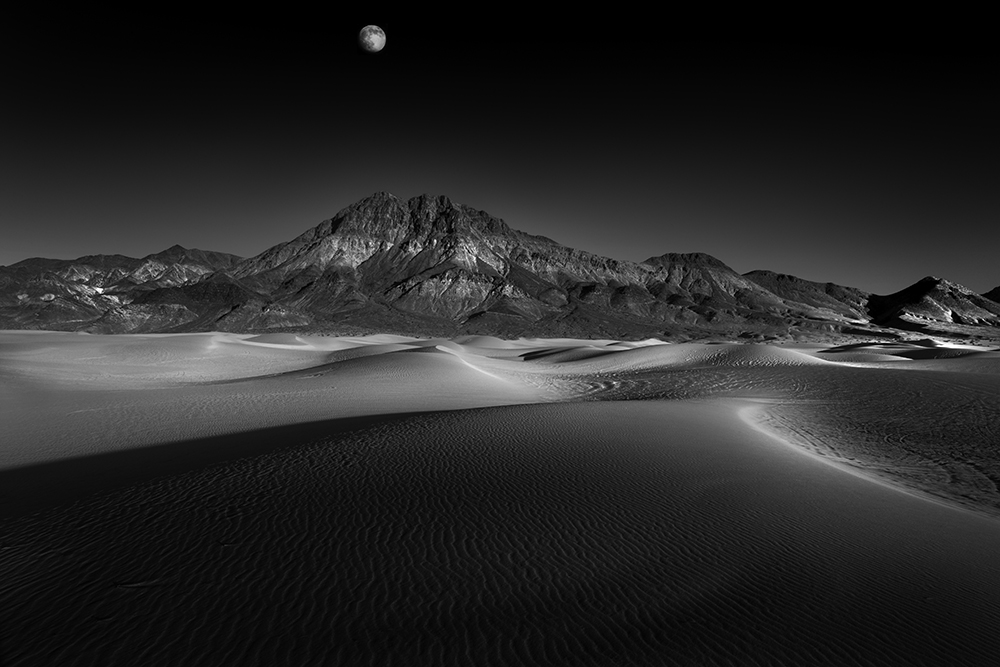

Today is Friday, tomorrow morning I’ll be in the car and driving to Death Valley. I go there every year about this time, alone, to create. I really enjoy this trip for both the location and the solitude. It’s where I recharge my creative batteries by blocking out the rest of the world and focusing on just one thing: seeing.
I’m just going to write my random thoughts as I embark on this trip, and as I’ve been writing three articles for the last two weeks, my mind is a muddle of thoughts. All semi-gelled and semi-fluid at the same time.
Location, does it matter? Theoretically it shouldn’t, I should be able to find a great shot in my bathroom. But the reality is that going somewhere new does seem to help us see anew and fresh. I don’t need a fantastic location like Yosemite which wears all it’s beauty close to the surface, just somewhere where my eyes can see it freshly.
Shooting alone or with others? I never can photograph with others present, I must be alone. When I have others with me I am constantly focused on if I’m inconveniencing them by staying out too long. Plus if there was someone with me I’d have to talk. I don’t want to talk on these trips, I just want to see and think.
Expectations. Sometimes when I go on these trips I have expectations that I must bring something great back or I’ll disappoint others. I need to lose any sense of obligation to others and only seek to please myself. If I come home and I didn’t find anything, then that’s okay. You cannot force creativity, in fact I think that this actually retards the process. Let it be. In truth if I come home with just one decent image, I’ll be as happy as a bird with a french fry!
Photographing where billions have photographed before. Yes, going to a widely photographed location such as Death Valley has its drawbacks, everything has been photographed a BILLION times. That is why I avoid the typically photographed spots or at least if I do go there, I try to photograph them differently. Remember that anyone can stand where Ansel Adams stood, frame the shot the same way and produce a nice shot. But in the end it will only be an weak imitation and is that really what you want to do, imitate others? The key is photographing with your vision, that’s what will make the images uniquely yours.
Isolation. I’ll be isolated for two weeks and I’ll love it. After these trips I always become more appreciative of people, a little friendlier and more centered. City life is grueling and not so good for the soul.
Mexican food. I’ll be stopping at every little hole-in-the-wall Mexican restaurant, looking for that local hidden secret. Mexican food is the best!
What’s important in life? I was recently asked in an interview to describe my perfect day, here is what I said:
With my many years of experience, I’d answer this question much differently than I would have when I was younger! Strangely enough the perfect day may not involve photography at all. Despite how much I love photography, I do not love it more than my family or my life. Photography is not my life, but it is one of those special things that help me to enjoy life.
A perfect day would be spent with my family and new grandson. We would spend the morning walking around the cove, and then we would dive the La Jolla ecological reserve and finish up by picnicking on the grass overlooking the Cove. I’d then slip away and go do some long exposure work while relishing the feel of the warm sun on my face, listening to the sounds of the beach, enjoying the smells and just being grateful that I could enjoy it all. And oh yes, we’d have Mexican for dinner!
Death Valley is such a wonderful place and especially so in the winter; it’s isolated, uncrowded and seeming barren. I say “seemingly” because if you stop, sit and look you will see the truth. It just takes some patience and time to see. But that’s also true life, slowing down and taking the time to look will reveal much.
Goodbye. I hope I’ll be back in a few weeks.
Cole
October 21, 2011
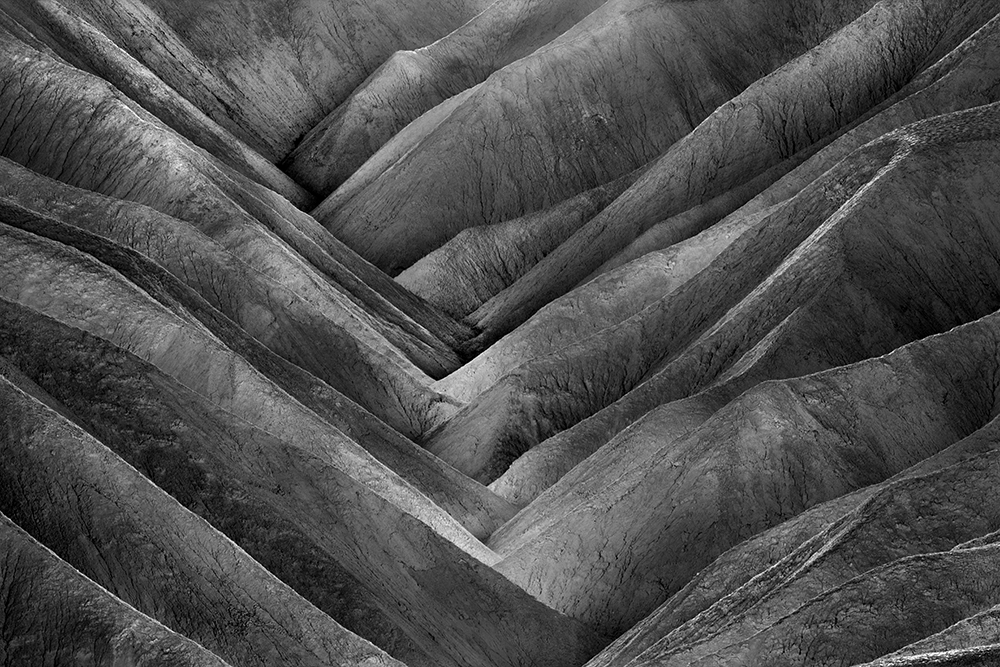
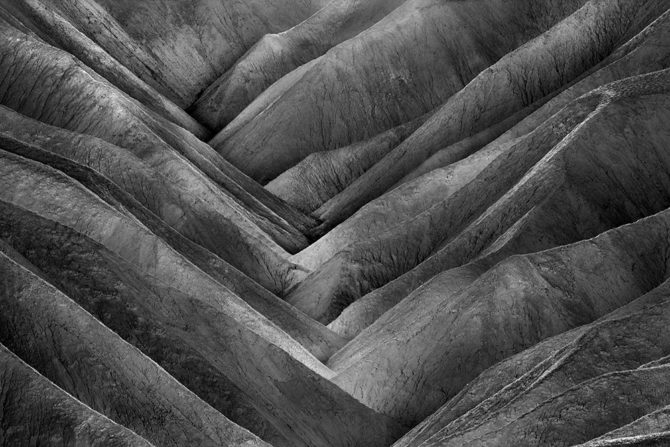
This is “Time No. 2” that I created at Zabriskie Point in Death Valley, perhaps the most photographed spot in the entire park. This image was created just before the sun went down and it’s amazing how Zabriskie Point can look so differently as the light changes from morning, to noon and to late afternoon.
Today I wanted to show a “before and after” so you could see what the original image looked and how your vision can change it. Sometimes vision takes place as you’re shooting and sometimes it occurs when you’re processing the image. And sometimes your vision changes over time and so you go back and change the image repeatedly (you should see how the The Angel Gabriel has evolved over time).
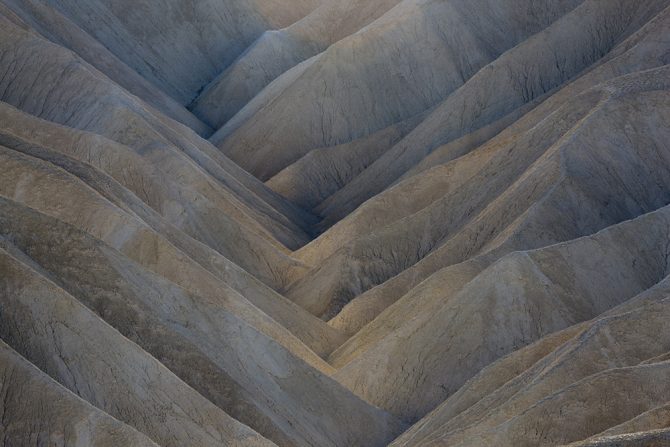
This original image is quite flat and muted, and so to make this a “Cole Thompson” image, I had to improve the contrast and separate the colors. I do this by adjusting the color channels in the black and white conversion tool of Photoshop CS5. By sliding each color’s adjustors in both directions, you can see how it will affect the contrast and separation. With the colors I had in this image, I was able to change the b&w version quite a bit by adjusting the color channels; the Red and Yellow channels brought out highlights, the Blue channels darkened certain parts of the image, and the green had no effect. When adjusting the channels, be careful not to go so far that you introduce unacceptable amounts of noise, particularly in the blue channels.
I then dodge and burn the image with my tablet to further enhance the contrast. In this image I used a very small brush to individually work each piece of the image so that I brought out the striations that separated each set of hills. I particularly paid attention to the ridge tops and brought out the highlighted edges.
One of the most important steps in my conversion process is to use the “Histogram” to check the blacks and white and then to adjust them using “Levels” if necessary (it’s almost always necessary). After you have established a good black and white, you can use “Levels” to adjust the midtones and really change the mood of your image, for my images I generally am pushing the midtones darker.
Once the image looks great on screen, I then use the global contrast adjustment to push the contrast even further so that it will print with the same “pop” that it has on screen. Remember that a monitor uses transmitted light and that always makes things look better than it will on a print. The reason for this is that a print uses reflected light which is quite dull and flat by comparison. By pushing the contrast further than you think you should, it will help ensure the printed piece looks good.
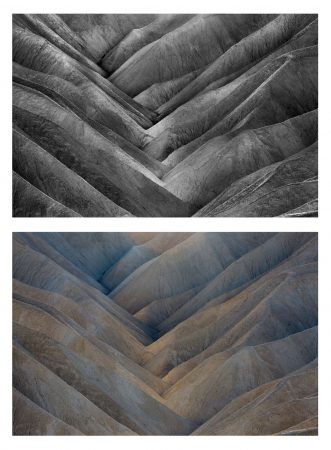
For me, the appeal of this image is it’s simplicity, it’s detailed contrasts and the compressed perspective. Death valley is really a spectacular place, especially in the winter. I go each January and just revel in the timeless solitude.
Cole
P.S. What I don’t like about side by side comparisons is when someone always writes and says “I like the color image better!” I’m just kidding of course, we all have our individual tastes and mine just runs to the black and white.
September 22, 2011
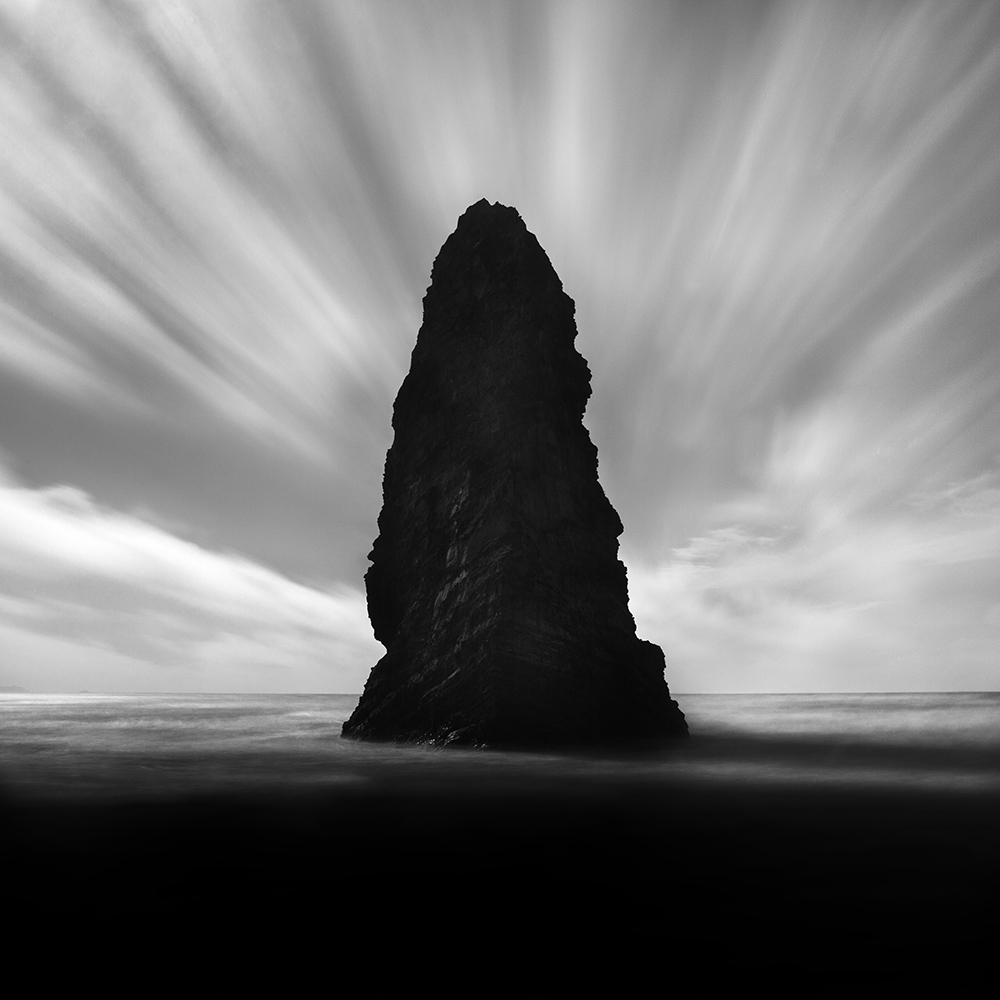

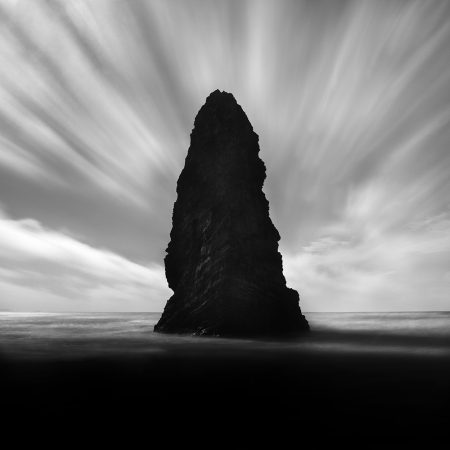
I’ve just returned from my annual Bandon trip where I take 10 days and think only about one thing: my art. Every year I worry if I’ll see something that inspires me and I get myself all worked up over it: Will I find something? What if I don’t? I’ve only 5 days left, now the pressure really is on!
It’s kind of like those nights when you just cannot get to sleep and you keep watching the clock, and with every hour the pressure increases because you have one less hour. It’s counter productive, we know, but we do it anyway.
So after days of walking and looking, something caught my eye. I was at a spot on the coast where the wind surfers congregate because of the fierce winds. Another affect of the winds are these magnificently crafted dunes that are compressed into a very small space between the surf and the cliffs. In that tight space wonderful shapes and shades of light are formed, different from what I normally see at traditional sand dunes.
It was there that inspiration struck; suddenly, unexpectedly and spontaneously. I saw something in those dune details that inspired me and I worked like crazy, everywhere I looked I saw something magnificent. I came back by a day later and I saw anew all over again. I ended up creating about 25 images for a new portfolio (title at present, unknown). The above image is one of my favorites from this new series.
Despite the pressure we put on ourselves, inspiration cannot be rushed. It just happens and when it does, you’ll know it by your excitement and how easy the images come together.
Cole
P.S. My next newsletter will be out in about two weeks and I’ll have this new series along with some other images from my Bandon trip.
November 8, 2009



I recently visited the Northern California coast. Part of me wanted to photograph there because so many of my photographic heroes have, and yet another part of me said: “What can I create that is better or different than what they have done?”
For me the answer was to go, to enjoy the beauty, to be inspired and to try! I know that this coastline still has many famous images to give, but only to those who have the eyes to see them. Every place, no matter how small or mundane, has great images to give, so how much better to be in this beautiful place?
I did create several new images; some are conventional ones such as “Diminishing Cliffs” above, but my primary focus was to complete “The Lone Man” series. I’ll be introducing some of those new images in my next newsletter, due out in about a week.
Another very enjoyable part of my trip was to have lunch with my friend and classic photographer Huntington Witherill. He’s been in LensWork a few times and he creates in both b&w and color. I love his work so much that I own two of his images, please check out his work.
This was a great trip. If you have a chance to visit this area, I’d recommend it as it’s both inspiring and a piece of photographic history.
Cole
July 8, 2009
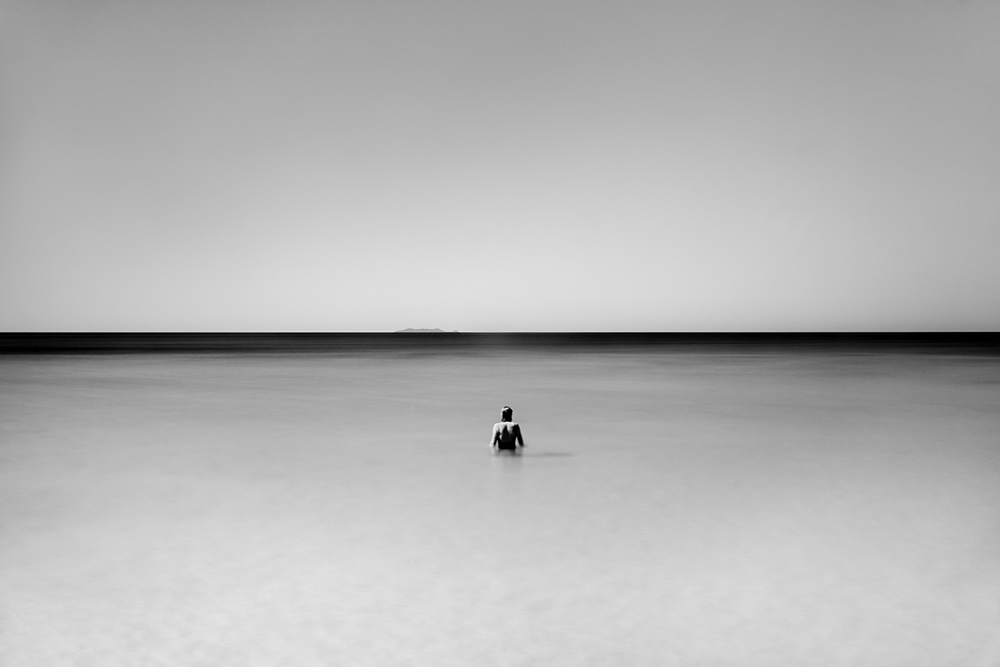

People ask me, how do you find people who stand still for so long?
Something unusual happens when a person stands on the beach and stares outward. They become still. You can almost see their thoughts as they ponder something much greater than themselves.
Where did we come from?
What is my purpose?
Where am I going after this life?
What does it all mean?
Who created it all?
Is there a grand plan?
Does my life have meaning?
Is this all there is?
What is beyond, the beyond?
Do I make a difference?
Is there a God?
People are affected by this time of meditation and they vow to make changes in their lives. But soon these weighty questions are replaced with others; McRib or Big Mac? Large or extra large fries? Should I try that new green milkshake?
See the Lone Man Series
June 12, 2009
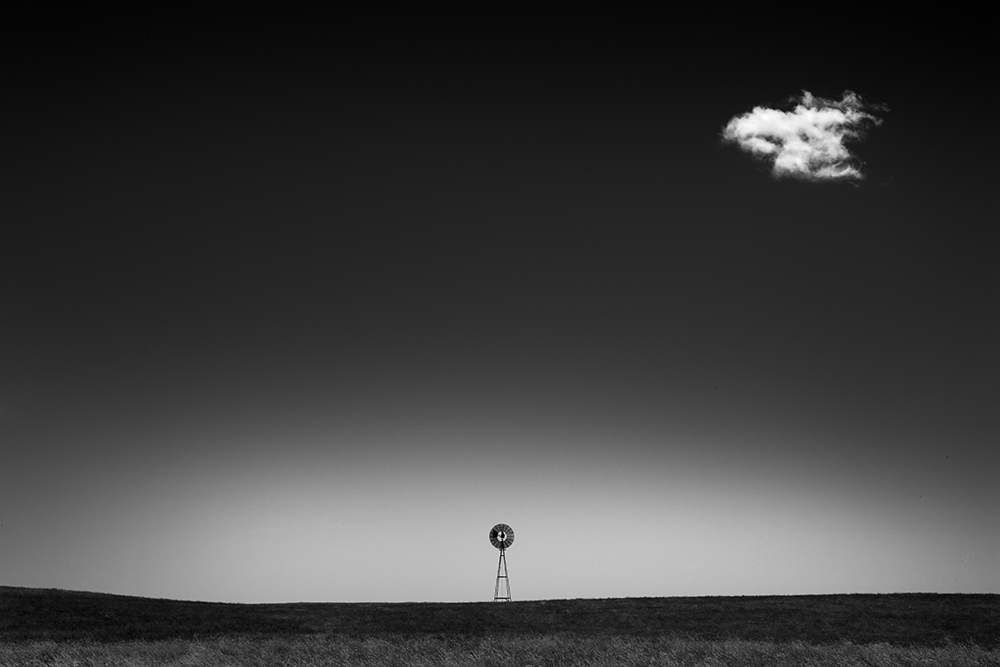
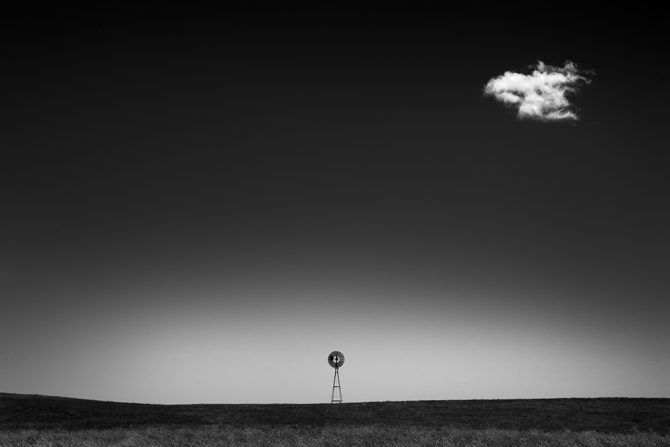
When I created my first Harbinger image, I broke the “centering” rule.
When I created the next and the next and the next, I centered them also. It just felt right.
But about a week ago I created the new image above, and decided not to center the cloud.
The definition of “harbinger” is:
\?här-b?n-j?r\ noun
That is exactly what I see when I create each Harbinger image, a foreshadowing of future events.
May 11, 2009
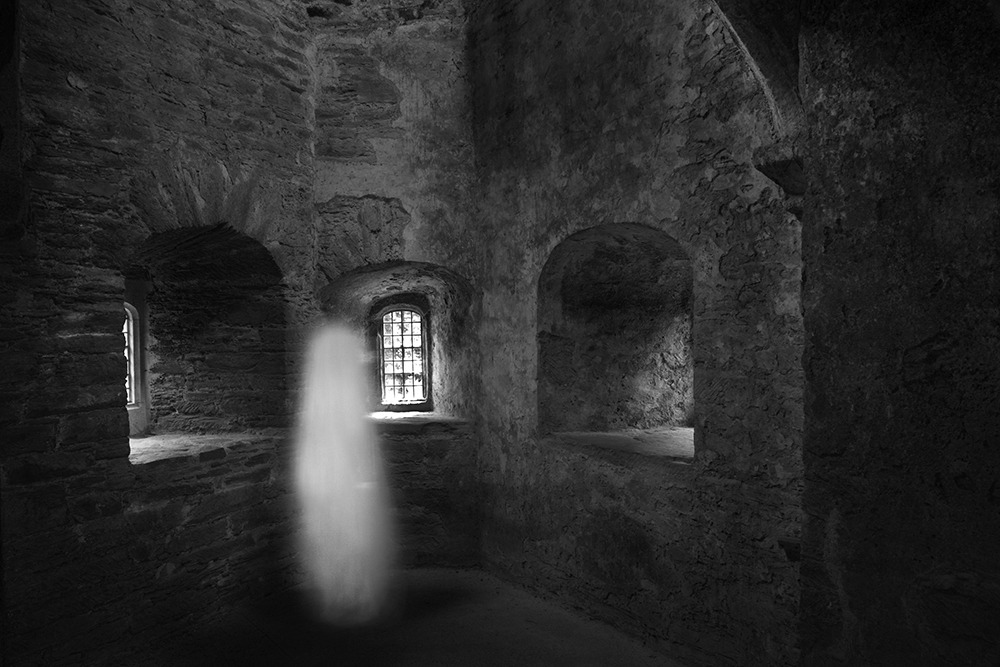
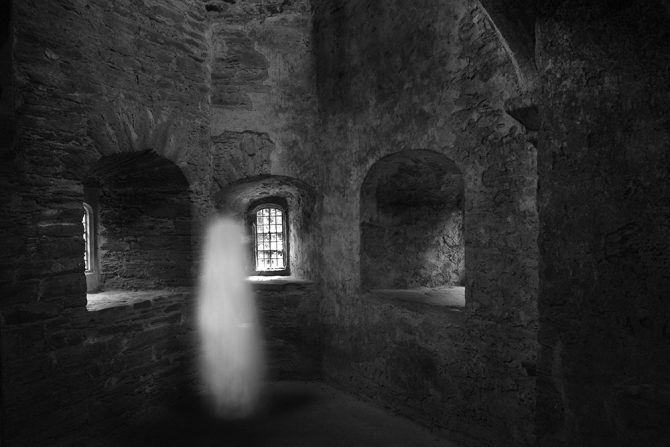
I’m still in England, but the visit is nearing the end. We spent the first week in a extremely small village on the southern coast and visited Stonehenge and several ancient castles. While there, I did get excited about an image or two and and I’m tentatively calling my new work “The Ghosts of Ancient England.”
The image above was created at the Berry Pomeroy Castle, which is rumored to be haunted…here’s a bit of the castle’s history:
The ruins of Berry Pomeroy Castle, reputed to be one of the most haunted castles in Britain, stand on a steep wooded hillside above the Gatcombe Brook.
It was built in the 15th century as a fortified house for the Pomeroy family, and was later sold to the Seymour family who built a new mansion house within the defences of the original castle.
A plan to further enlarge the house was never completed and the castle was abandoned by the beginning of the 18th Century.
When I return home I’ll complete these images and hope to have the beginnings of a new body of work.
Cole
